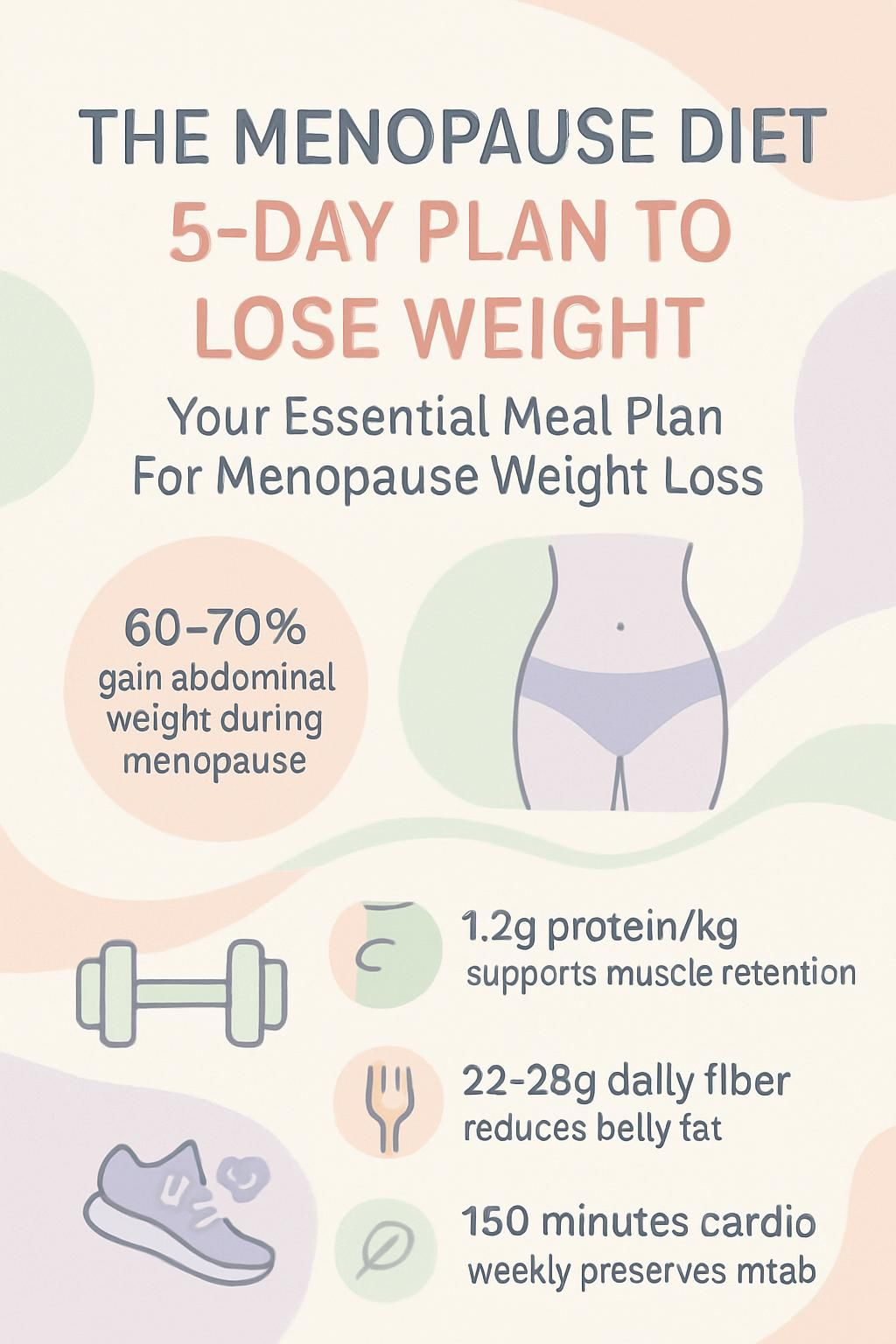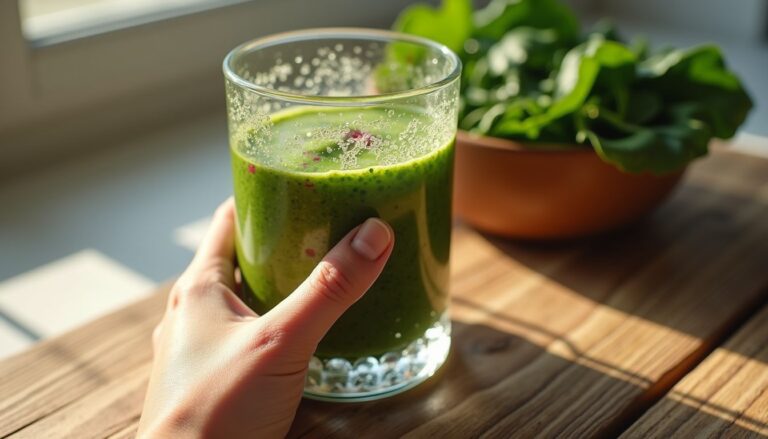The Menopause Diet 5-Day Plan To Lose Weight: Your Essential Meal Plan For Menopause Weight Loss
Our Nutrition Assistant AI Suite will transform your body. You will lose fat, get toned, and build muscle. Gain confidence and optimal health.
If you are facing weight gain during menopause, you are not alone. About 60 to 70 percent of women gain belly fat during this transition. A clear menopause diet plan can help you manage weight, reduce symptoms, and feel more in control.
The Menopause Diet 5 Day Plan To Lose Weight gives you simple steps and balanced meals. You will see how to choose the right foods, time your meals, and build daily habits that stick. Small changes add up fast.
Start today and give your body steady fuel for this new stage.
Key Takeaways
- Lower estrogen, slower metabolism, and higher insulin resistance drive belly fat for 60 to 70 percent of women in menopause, raising risk for type 2 diabetes and heart disease.
- The Menopause Diet 5-Day Plan highlights lean protein at about 1.2 grams per kilogram of body weight, whole foods, and high-fiber meals to protect muscle and steady energy.
- Eating at least 22 to 28 grams of fiber per day can trim belly fat by up to 3.7 percent and improve blood sugar control in studies.
- Pair 150 minutes of weekly cardio with strength training to preserve muscle and metabolism; low-impact options like walking and yoga protect joints.
- Limiting processed foods, added sugars, caffeine, and alcohol supports hormone balance, sleep quality, and more consistent weight loss.

How Does Menopause Cause Weight Gain?

Hormone shifts and a slower metabolism can change where your body stores fat. Many women notice extra weight around the abdomen, even if food choices have not changed much.
What hormonal changes affect weight during menopause?
Estrogen levels can drop by about half during menopause. This shift changes how your body uses and stores energy. Fat often moves from hips and thighs to the belly, increasing abdominal obesity fivefold after menopause.
Falling estrogen and progesterone can raise insulin resistance, which makes it easier to gain fat and harder to lose it. If testosterone stays the same or rises, metabolism may slow further.
These changes increase risk for type 2 diabetes and cardiovascular disease. With more belly fat and less lean mass, weight management during menopause becomes more challenging.
How do slower metabolism and muscle loss impact weight?
Muscle naturally declines with age. After 30, adults lose roughly 3 to 8 percent of muscle each decade, and the pace often speeds up after 50.
Less muscle means your body burns fewer calories at rest. Clothes can feel tighter even if the scale stays the same, because muscle drops while fat increases. During my own transition, lifting weights and eating more protein helped me keep muscle and feel stronger.
“Losing muscle with age can slow your metabolism, making it easier to gain weight even if your habits do not change.”
Staying active and eating to protect muscle are two of the best tools you have in this stage.
Key Principles of the Menopause Diet
This plan centers on whole foods, lean protein, and fiber. The goal is simple, support a healthy metabolism and reduce common menopausal symptoms.
Why prioritize lean protein in the menopause diet?
Protein protects muscle, which supports a higher resting metabolic rate. As estrogen drops, the body tends to lose skeletal muscle and gain body fat, especially at the waist.
Aim for about 1.2 grams of protein per kilogram of body weight each day. A 70 kilogram person would target around 84 grams. Good options include chicken breast, tofu, fish, eggs, and Greek yogurt.
Higher protein meals also help control appetite and steady energy. Many postmenopausal women see less belly fat when protein is included in each meal.
How to incorporate whole foods effectively?
Protein works best alongside whole foods that deliver fiber and micronutrients. Choose whole grains like quinoa, brown rice, and oats instead of refined grains. Add berries, apples, and oranges for snacks.
Load half your plate with non-starchy vegetables like spinach, broccoli, carrots, tomatoes, or kale. Use beans, lentils, and edamame to boost plant protein and fiber. The Mediterranean diet pattern favors these foods because they support heart health and steady energy.
Prep ahead to make whole choices easy. Keep sliced vegetables in clear containers, cook a pot of quinoa, and store lean proteins for quick meals. Olive oil is a smart fat for cooking and dressing.
“Whole foods deliver lasting energy and nutrients that support your body during menopause,”
says the North American Menopause Society.
Choosing whole foods at each meal can help you manage weight and ease symptoms over time.
What are the benefits of increasing fiber intake?
Fiber supports weight control and digestion. Research shows that adding 10 grams of soluble fiber per day can reduce belly fat by about 3.7 percent.
Top sources include broccoli and other cruciferous vegetables, beans, avocados, oats, nuts, and seeds. Fiber slows digestion, helps you feel full longer, and smooths blood sugar swings.
As I increased fiber and cut packaged snacks, bloating fell and cravings eased. Regular intake also supports a healthy gut and more stable energy.
How does reducing processed foods and added sugars help?
Processed foods and added sugars can spike blood sugar and increase insulin resistance. Many bars, sweet drinks, and desserts have a glycemic index of 70 or higher.
Choosing whole foods keeps energy steadier and reduces fat stored around the waist. Build meals with whole grains, lean proteins, leafy greens, dairy like yogurt, nuts, and fresh fruit.
When I swapped soda for water and traded packaged sweets for an apple or almonds, energy improved within two weeks. Small swaps make a big difference.
What Are the Benefits of a Balanced Menopause Diet?
A balanced plan helps you lose weight during menopause, supports hormones, and boosts daily energy. It also protects long-term health.
How does it support hormonal balance?
Whole foods, lean protein, and healthy fats can help stabilize hormones. Soy foods like tempeh, edamame, and miso contain phytoestrogens, plant compounds that act like mild estrogen in the body. They may reduce hot flashes for some women.
Fiber from fruit, vegetables, and whole grains supports insulin sensitivity. During my transition, meals built around oats, leafy greens, flaxseeds, and plenty of water helped smooth mood swings.
How does it promote weight management?
Balanced meals reduce empty calories and sharpen hunger cues. Vegetables and whole grains give volume and fiber. Lean proteins, such as chicken, fish, and soy, help maintain muscle so you burn more calories at rest.
Losing even 5 percent of your starting weight can lower risk for diabetes and heart disease. A 5-day menopause meal plan keeps portions consistent and makes it easier to avoid overeating. I saw fewer cravings when I added beans, nuts, and intact grains to my usual meals.
How can it enhance energy levels?
Meals with protein, fiber, and healthy fat prevent energy crashes. Eggs with spinach at breakfast, for example, offer steady fuel for hours. A 2022 study found that balanced meals reduce afternoon slumps and improve focus.
Trading packaged snacks for Greek yogurt or nuts gave me more consistent energy and less stress. Whole grains also power you from one meal to the next.
How does it improve overall health?
A balanced menopause diet supports your heart, bones, and immune system. Whole grains, fruits, and vegetables provide antioxidants that may reduce risk for certain cancers, including breast and colon cancer.
Lean protein preserves muscle, and fiber supports healthy cholesterol. Nuts and seeds supply fats that help you absorb vitamins A, D, E, and K, which are key for bones as estrogen falls. Cutting processed foods trims sodium, which supports blood pressure control.
The Menopause Diet 5-Day Plan to Lose Weight
This sample plan uses simple, satisfying meals. Each day balances protein, fiber, and healthy fat to manage weight and common symptoms.
What does Day 1’s meal plan include?
Start with a tomato and basil omelet for protein that supports muscle. Lunch is a chicken and avocado salad with leafy greens for fiber and healthy fats. Choose a small handful of nuts for a snack.
Dinner features Cajun salmon with a nectarine, almond, and arugula salad for vitamins and omega 3 fats. If you want something sweet, have a square of dark chocolate instead of sugary treats.
Target around 1.2 grams of protein per kilogram of body weight daily. If you weigh 70 kilograms, aim for about 84 grams. If you exercise, a low sugar protein shake can help you reach your goal without extra added sugar.
Planning each meal kept my energy steady and cut cravings during perimenopause. A simple weekly plan builds momentum fast.
What are the features of Day 2’s low-glycemic meals?
Day 2 focuses on low glycemic foods to keep blood sugar even. Choose oats, barley, or quinoa as your main carbohydrate sources. Include lean protein like grilled chicken or fish at each meal.
Add nuts or seeds for snacks and pair meals with leafy greens, broccoli, or bell peppers. Enjoy fruit in moderation. Strawberries or apples give fiber with a smaller sugar load.
Skip white bread, sugary cereals, sodas, candy, and baked goods with added sugars. Drink water throughout the day. These choices help you feel full longer and steady your energy.
How to pack Day 3 meals with fiber-rich foods?
Fill Day 3 with fiber. Breakfast can be chia pudding with almond milk and berries, a mix of soluble and insoluble fiber that supports digestion.
Build a chickpea salad with leafy greens, tomatoes, cucumbers, and lemon dressing for lunch. For dinner, try a bean and vegetable stew or tofu with stir fried broccoli or Brussels sprouts. A half cup of beans adds 6 to 8 grams of fiber.
Adding chickpeas or chia seeds each day reduced my late afternoon hunger. Snack on carrots, nuts, or apple slices to lift fiber and satisfy cravings.
What plant-based meals are included on Day 4?
Day 4 centers on plant proteins and fiber. Start with tahini lentils for breakfast, which pack protein and keep you full.
Lunch is a kale salad with pistachios and pears in a balsamic dressing. For dinner, stay fully plant based with extra lentils or chickpeas, or add a small portion of fish or chicken if you prefer.
Each meal supports weight management with nutrient dense vegetables, seeds, and whole foods.
What balanced meals are recommended for Day 5?
For breakfast, make a mushroom omelet with a side of sweet potato hash. Mushrooms offer B vitamins for metabolism, and sweet potatoes provide fiber with slow digesting carbs.
Lunch can be quinoa tossed with almonds, roasted Brussels sprouts, and chopped dates. Quinoa gives complete protein, and almonds add healthy fats that support hormone balance. Brussels sprouts support bone health with vitamin K and folate.
Dinner is black bean tacos with zucchini chips and guacamole. Black beans steady blood sugar with fiber and protein. Zucchini chips add crunch without deep frying, and guacamole brings heart friendly monounsaturated fats.
How Can You Succeed on the Menopause Diet?
Success comes from small, steady habits. Build routines that are easy to repeat on busy days.
Why is staying hydrated important?
Water supports metabolism, digestion, and temperature control. It can also ease hot flashes, fatigue, and dry skin. Drinking a glass before meals may help you manage portions and reduce cravings for sugary drinks or extra caffeine.
Carrying a reusable bottle made meeting my water goals simple. Hydration also supports better mood and mental clarity during stressful days.
How to practice portion control effectively?
Use smaller plates to reduce serving sizes. Research shows this can cut calorie intake by up to 30 percent. A kitchen scale offers more accuracy than guessing.
Tracking apps, such as MyFitnessPal, help you stay aware of how much you eat. A short food journal can reveal triggers for emotional eating. I learned I was overdoing nut butter once I started logging. Weekly weigh ins helped me see steady progress.
Why limit caffeine and alcohol?
Both can disrupt sleep, which often worsens during menopause. Alcohol adds extra calories and may increase belly fat. Heavy drinking means more than 3 drinks per day or over 7 to 8 drinks in a week. Aim to limit intake to small portions a few days per week.
Too much caffeine can cut sleep quality and drive cravings the next day. Cutting back on wine reduced my bloating and gave me steadier energy. Herbal tea and seltzer are simple swaps.
How to plan and prep meals in advance?
Set one weekly prep day to plan, shop, and cook in batches. Many people choose Sunday. Use labeled containers with dates, and store ready to eat foods where you can see them.
Pack lunches and snacks the night before to avoid last minute temptations. Keep chopped vegetables and lean proteins on hand for quick assembly. In a national survey, 73 percent of meal preppers reported better adherence to diet and exercise plans.
What Are the Best Exercises for Menopause Weight Loss?
Exercise helps manage weight, mood, and bone strength. A mix of cardio and strength work gives the best results.
Why combine cardio and strength training?
Cardio burns calories during your workout. Strength training builds and preserves muscle, which raises your resting calorie burn for up to 48 hours after a session.
Experts recommend at least 150 minutes of moderate or 75 minutes of vigorous exercise per week. Cardio supports heart health; strength work supports muscle protein synthesis. Together they reduce body fat, protect bones, and lift mood.
What low-impact exercises support joint health?
Walking and yoga are gentle on joints and easy to keep up. Regular walking can lower osteoporosis risk and maintain bone strength as hormones shift.
Yoga builds flexibility without pounding the joints. Poses like Child’s Pose and Cat Cow ease common stiffness. Harvard Health reports that practicing yoga twice per week can reduce joint pain.
How to include daily walks or yoga?
Start with ten minutes a day. Brisk walking during lunch or after dinner fits most schedules. Comfortable shoes and a planned route make it easier to stay consistent. If weather is bad, walk in place while watching TV.
Short yoga sessions also help with stress and sleep. Try fifteen minutes of gentle poses in the morning or evening. I noticed my sleep improve within a week of adding quick sessions.
Which Foods Should You Include in the Menopause Diet?
Choose foods that support hormones, muscle, and steady blood sugar. These staples make building meals simpler.
What lean proteins are best?
Fatty fish like salmon supplies omega 3 fats and high quality protein. Skinless chicken breast and ground turkey are great low fat options. Plant proteins like firm tofu, tempeh, beans, and lentils provide protein and fiber without much saturated fat.
One cup of cooked lentils offers about 18 grams of protein and 15 grams of fiber. Adding baked salmon or lentil soup to my week helped me feel full longer and manage weight more easily.
Which healthy fats support menopause health?
Nuts and seeds, including walnuts, almonds, chia, and flaxseed, supply omega 3 and omega 6 fats. These fats help reduce inflammation and support heart health. One ounce of walnuts has about 2.5 grams of plant based omega 3s, and a tablespoon of ground flaxseed adds around 1.6 grams.
Avocado and olive oil are rich in monounsaturated fat, which supports cholesterol balance and satiety. The Mediterranean diet uses olive oil often and links to a lower risk of chronic disease.
What are the top high-fiber foods?
Focus on fiber to feel full and control blood sugar. Excellent choices include:
- Cruciferous vegetables, such as broccoli and Brussels sprouts
- Beans and lentils
- Avocado
- Oats
- Nuts and seeds, especially chia and almonds
Women over 51 should aim for 22 to 28 grams of fiber per day, according to the Dietary Guidelines for Americans. These foods also support heart health and digestion.
Which calcium-rich foods help bone health?
Menopause increases the risk of bone loss. Dairy foods are convenient calcium sources. Cheese has about 200 milligrams per ounce, and nonfat Greek yogurt provides around 250 milligrams per cup along with protein.
Cottage cheese adds calcium too, with roughly 140 milligrams per cup. Many experts suggest three servings of low fat dairy per day to meet needs while managing calories.
Which Foods Should You Avoid During Menopause?
Some foods can worsen symptoms or make weight control harder. Limiting them helps you stay on track.
Why avoid processed foods and refined carbs?
Refined carbs and ultra processed foods spike blood sugar and strain insulin response. Over time this can increase belly fat. Examples include white bread, pastries, chips, and sweetened drinks.
Women who eat more refined carbs tend to gain more weight around the waist. In a 2020 study, women eating more refined carbs gained up to 5 pounds in one year compared to those who chose whole grains.
Swapping fast food for nuts, lean proteins, and vegetables helped me steady my hunger and mood. Whole foods make it easier to control calories and support long term health.
How do sugary snacks and beverages affect menopause?
High sugar snacks and drinks cause quick spikes and drops in blood sugar. These swings can worsen mood swings and hot flashes. Diets high in added sugar also raise insulin resistance, which slows fat loss.
Women who consume more than 50 grams of added sugar per day often report worse symptoms and more belly fat. Replacing soda with water and choosing fruit with a few nuts helped my energy and focus.
What are the risks of excessive sodium and trans fats?
Too much sodium raises blood pressure, which increases heart disease risk. The American Heart Association suggests limiting sodium to less than 2,300 milligrams per day. Processed foods often hide large amounts of salt.
Trans fats raise LDL cholesterol and lower HDL cholesterol, which raises heart risk. Even small amounts, often in fried foods and packaged snacks, increase danger as we age. I saw better blood pressure and steadier energy after replacing frozen meals with home cooked dishes.
How Can Diet Help Manage Menopause Symptoms?
Smart food choices can ease bloating, protect bones, and stabilize mood. Consistent habits work best.
Which anti-inflammatory foods reduce bloating?
Nuts and seeds, such as almonds and chia, contain healthy fats that calm inflammation. Olive oil also supports gut health and smooth digestion.
Broccoli and Brussels sprouts add fiber that helps move waste through the digestive tract. Studies in 2022 suggest diets rich in nuts and olive oil can lower inflammatory markers tied to bloating.
Adding a small handful of nuts at breakfast and using olive oil on salads helped me feel less puffy within days.
How to support bone health with calcium and vitamin D?
Include calcium rich foods like cheese, Greek yogurt, and cottage cheese in your day. Your body needs vitamin D to absorb calcium well. Get safe sunlight and consider vitamin D from diet or a supplement if your clinician recommends it.
Combining calcium and vitamin D can help slow bone loss linked to lower estrogen levels. Fortified plant milks are an option if you avoid dairy.
What nutrient-rich meals help stabilize mood?
Meals that mix lean protein, complex carbs, and healthy fats can smooth mood and energy. Try oatmeal with walnuts and a side of Greek yogurt for breakfast. For lunch, grilled salmon over quinoa with leafy greens provides omega 3s and steady fuel.
Eating patterns rich in whole grains, vegetables, legumes, nuts, and seeds are linked with fewer mood swings during hormonal changes.1,2 Pair a small handful of almonds with fruit for a balanced snack.
Disclaimer: This article is for education only and is not medical advice. Speak with a healthcare professional for personal guidance, especially if you have medical conditions or take medication.
What Common Mistakes Should You Avoid on the Menopause Diet?
A few common missteps can slow progress. Avoid these to keep results moving.
Why is skipping meals or under-eating harmful?
Eating too little can slow your metabolism and increase cravings later. Irregular meals often lead to overeating in the afternoon or evening.
A 2019 study in Nutrients found that women who skipped breakfast had higher BMI than those who ate regular meals. I felt shaky and unfocused when I skipped lunch, then grabbed sugary snacks. Regular meals keep energy stable and reduce urges to snack.
What are the dangers of fad diets?
Fad diets promise fast results but often cut entire food groups or slash calories. This can cause deficiencies in calcium, iron, and fiber, which matter even more during menopause.
Quick fixes can worsen fatigue, speed muscle loss, and weaken bones. A detox tea once caused me to drop water weight, then rebound. Balanced plans are safer and more sustainable.
Data Table: Nutritional Deficiency Risks from Fad Diets
| Nutrient | Role in Health | Risk When Deficient |
|---|---|---|
| Calcium | Bone strength | Higher fracture risk |
| Iron | Energy production | Fatigue |
| Fiber | Digestion and fullness | Constipation |
Choose a well rounded meal plan to support weight loss, symptom relief, and long term health.
Why should exercise not be ignored?
Skipping exercise speeds muscle loss and lowers daily calorie burn. Women who move regularly gain less weight than those who do not.
Strength training and cardio together help preserve lean mass, improve mood, and support sleep. Short daily walks and simple home weights raised my energy and stabilized sleep during menopause.
Conclusion
A focused menopause diet plan, paired with regular activity, can help you lose weight, steady energy, and ease symptoms. The 5-day plan offers balanced meals built on lean proteins, whole foods, and fiber to support muscle, hormones, and heart health.
Use these steps as a structure you can repeat week after week. With consistency, you can manage menopause weight gain and support long term well being.
Selected sources: North American Menopause Society; American Heart Association; Harvard Health Publishing; Dietary Guidelines for Americans 2020–2025.1 Harvard T.H. Chan School of Public Health, 2021. 2 North American Menopause Society, 2020.
FAQs
1. What is the Menopause Diet 5-Day Plan for weight loss?
The Menopause Diet 5-Day Plan offers a structured meal plan designed to help women manage menopause symptoms and lose weight. This essential meal plan focuses on balanced nutrition, portion control, and evidence-based food choices that address hormonal changes during menopause.
2. How does alcohol affect the effectiveness of the Menopause Diet 5-Day Plan?
Alcohol can slow metabolism and add extra calories without nutritional value. Studies show that limiting alcohol intake supports better results with any diet plan, including those aimed at menopause weight loss.
3. Are there specific foods included in this essential meal plan for menopause weight loss?
Yes; the meal plan includes high-fiber vegetables, lean proteins like poultry or fish, whole grains such as brown rice or oats, and healthy fats from sources like nuts or olive oil. These foods support stable blood sugar levels and promote satiety throughout each day.
4. Can personal experience improve success with this diet plan?
Personal stories often highlight how following a clear structure helps maintain motivation during challenging times such as menopause transition. Many individuals report feeling more energetic after five days of consistent meals tailored to their needs.
Summary: The Menopause Diet 5-Day Plan uses proven strategies to guide women through dietary adjustments needed for effective weight management during midlife changes. Limiting alcohol intake enhances outcomes while nutrient-rich foods form the core of daily menus; personal experiences reinforce its practical benefits for real-life application.







